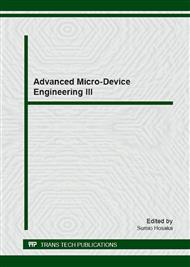p.82
p.88
p.93
p.99
p.107
p.113
p.118
p.122
p.126
Comparison of Nanosized Pattern of Calixarene and ZEP520 Resists by Using Energy Deposition Distribution
Abstract:
We numerically modeled the process of exposure and development of the calixarene negative resist and ZEP520 positive resist in electron beam lithography (EBL) in order to understand the limitation of nanopatterning of these two resists and to improve the resolution of the patterning. From the calculation of energy deposition distribution (EDD) in resist at various beam diameters, it is obvious that the fine probe beam with a diameter of 2 nm and thin resist should be adopted for formation of very fine dots. The simulation of resist development profile indicates that a dot size of 2 nm with a pitch of 20 nm can even be obtained at a higher critical energy density by using calixarene resist, while it cannot form the small pattern by using the ZEP520 resist because of the capillary force.
Info:
Periodical:
Pages:
107-112
Citation:
Online since:
January 2013
Authors:
Price:
Сopyright:
© 2013 Trans Tech Publications Ltd. All Rights Reserved
Share:
Citation:


